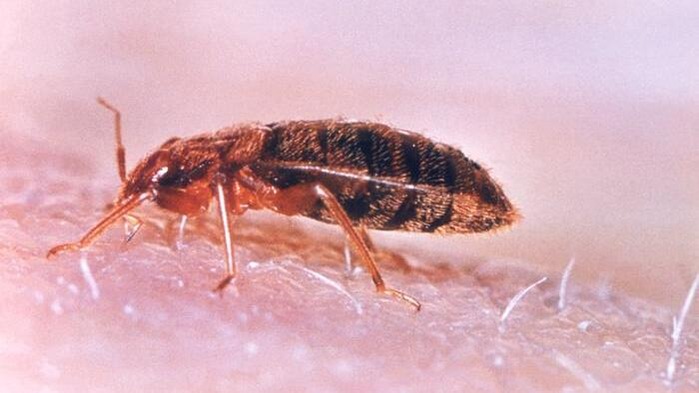What to know
- Bed bugs are not known to spread diseases to people.
- Bites can cause itching, loss of sleep, and, rarely, allergic reactions.
- Prevent bed bugs by regularly looking for signs of infestation.
More Information

Overview
Bed bugs (Cimex species) are small, flat insects. Bed bugs bite people and animals at night while they sleep, feeding on their blood.
Bed bugs are reddish-brown in color, are wingless, and range from 1mm to 7mm in size (roughly the size of Lincoln's head on a penny). They can live several months without a blood meal.
Bed bugs are not known to spread diseases to people. However, they cause irritation, itching, and loss off sleep. Removal from dwellings can be expensive and inconvenient to remove.
Where you can find bed bugs
You can find bed bugs anywhere, from North and South America, to Africa, Asia, and Europe. Bed bugs are in five-star hotels and resorts. How clean a place is does not determine whether bed bugs are present.
Signs and symptoms
Although bed bugs are not known to spread diseases to people, they can cause itching and loss of sleep. Sometimes intense itching can lead to excessive scratching and possibly a secondary skin infection. An allergic reaction to several bites is possible. If you think you are having an allergic reaction to bed bug bites, speak with your healthcare provider.
How to tell if you've been bitten
Bed bug bites affect each person differently. Signs of a bed bug bites include
- No physical signs
- Small bite marks
- Serious allergic reactions (rare).
When bed bugs bite, they inject fluids (anesthetic and anticoagulant) that prevents a person from feeling the bite when it happens. Most people do not notice the bite marks until they appear from one to several days after the initial bite.
Bites look similar to mosquito or flea bites—a slightly swollen and red area that may itch and be irritating. The bite marks may be random or appear in a straight line.
Other symptoms of bed bug bites include insomnia, anxiety, and skin problems that arise from intense scratching of the bites.
Allergic reactions are possible
Allergic symptoms can include enlarged bite marks, painful swellings at the bite site, and, on rare occasions, anaphylaxis. If you think you are having an allergic reaction to bed bug bites, speak with your healthcare provider.
Exposure risks
Everyone is at risk for getting bed bugs when visiting an infested area. However, you are at higher risk of getting bed bugs if you travel frequently and share living and sleeping space where other people have previously slept.
Causes and spread
Bed bugs are experts at hiding. Their slim flat bodies allow them to fit into very small spaces. They can go long periods of time without a blood meal.
Bed bugs spread by getting into the seams and folds of luggage, overnight bags, folded clothes, bedding, furniture, and anywhere else they can hide. Most people do not realize they are transporting bed bugs and infecting areas as they travel.
Resource
Reducing risk
Early detection and eradication of bed bugs can make infestations easier to control. For those that travel, it may be helpful to look for signs of infestation, such as exoskeletons or bed bugs in folds of mattresses and sheets, in sleeping areas.
Where to look for bed bugs
Bed bug infestations usually happen around or near areas where people sleep. This includes apartments, shelters, houses, hotels, cruise ships, buses, trains, and dorm rooms.
The bugs hide during the day in places on or around the bed. They can hide in
- The seams of mattresses
- Box springs
- Bed frames and headboards
- Dresser tables
- Inside cracks or crevices
- Behind wallpaper
Bed bugs can travel over 100 feet in a night but tend to live within 8 feet of where people sleep.
Signs of an infestation
One of the easiest ways to identify a bed bug infestation is by bite marks on the face, neck, arms, hands, or any other body parts after sleeping. However, these bite marks may take as long as 14 days to develop in some people. It's important to look for other clues to determine if you have an infestation.
Look for
- Exoskeletons (shed after molting),
- Bed bugs in the fold of mattresses and sheets,
- Rusty–colored blood spots on mattresses or nearby furniture, and
- A sweet musty odor.
Treatment
Treating bites
Bed bug bites can cause inflammatory reactions in some people, but usually do not require medical treatment. The best way to treat a bite is to apply antiseptic creams or lotions to help with itching and to avoid scratching the area (to prevent secondary infections). For people with itchy inflammatory reactions, an antihistamine may help control the itching.
Treating infestations
If you think you have a bed bug infestation, contact a professional pest control company experienced with treating bed bugs. They will typically spray insecticides to treat the area.
